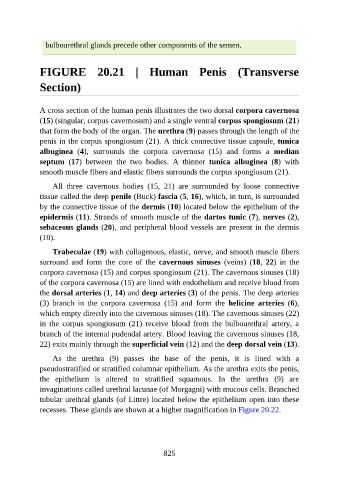Page 826 - Atlas of Histology with Functional Correlations
P. 826
bulbourethral glands precede other components of the semen.
FIGURE 20.21 | Human Penis (Transverse
Section)
A cross section of the human penis illustrates the two dorsal corpora cavernosa
(15) (singular, corpus cavernosum) and a single ventral corpus spongiosum (21)
that form the body of the organ. The urethra (9) passes through the length of the
penis in the corpus spongiosum (21). A thick connective tissue capsule, tunica
albuginea (4), surrounds the corpora cavernosa (15) and forms a median
septum (17) between the two bodies. A thinner tunica albuginea (8) with
smooth muscle fibers and elastic fibers surrounds the corpus spongiosum (21).
All three cavernous bodies (15, 21) are surrounded by loose connective
tissue called the deep penile (Buck) fascia (5, 16), which, in turn, is surrounded
by the connective tissue of the dermis (10) located below the epithelium of the
epidermis (11). Strands of smooth muscle of the dartos tunic (7), nerves (2),
sebaceous glands (20), and peripheral blood vessels are present in the dermis
(10).
Trabeculae (19) with collagenous, elastic, nerve, and smooth muscle fibers
surround and form the core of the cavernous sinuses (veins) (18, 22) in the
corpora cavernosa (15) and corpus spongiosum (21). The cavernous sinuses (18)
of the corpora cavernosa (15) are lined with endothelium and receive blood from
the dorsal arteries (1, 14) and deep arteries (3) of the penis. The deep arteries
(3) branch in the corpora cavernosa (15) and form the helicine arteries (6),
which empty directly into the cavernous sinuses (18). The cavernous sinuses (22)
in the corpus spongiosum (21) receive blood from the bulbourethral artery, a
branch of the internal pudendal artery. Blood leaving the cavernous sinuses (18,
22) exits mainly through the superficial vein (12) and the deep dorsal vein (13).
As the urethra (9) passes the base of the penis, it is lined with a
pseudostratified or stratified columnar epithelium. As the urethra exits the penis,
the epithelium is altered to stratified squamous. In the urethra (9) are
invaginations called urethral lacunae (of Morgagni) with mucous cells. Branched
tubular urethral glands (of Littre) located below the epithelium open into these
recesses. These glands are shown at a higher magnification in Figure 20.22.
825

